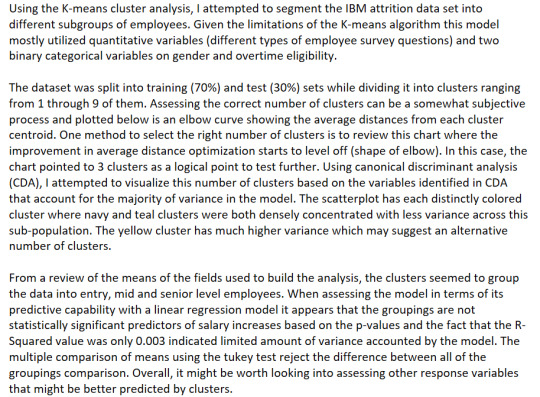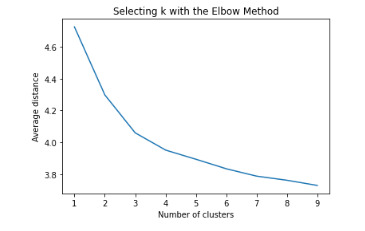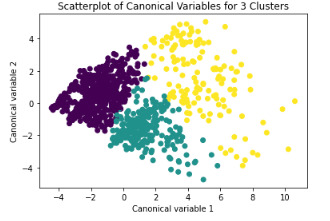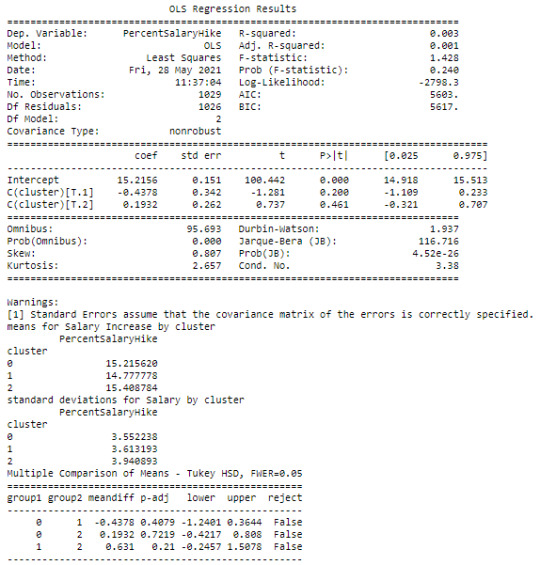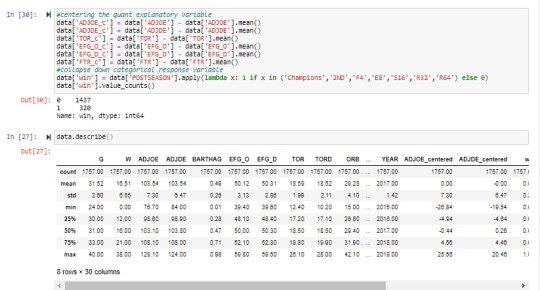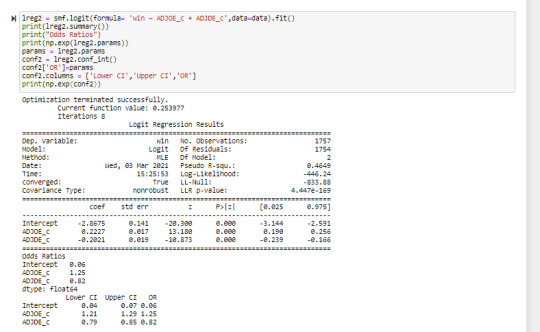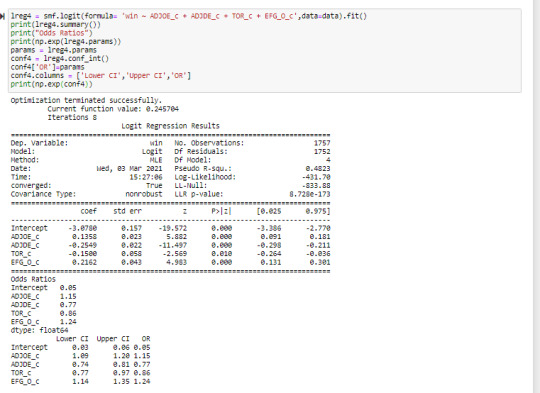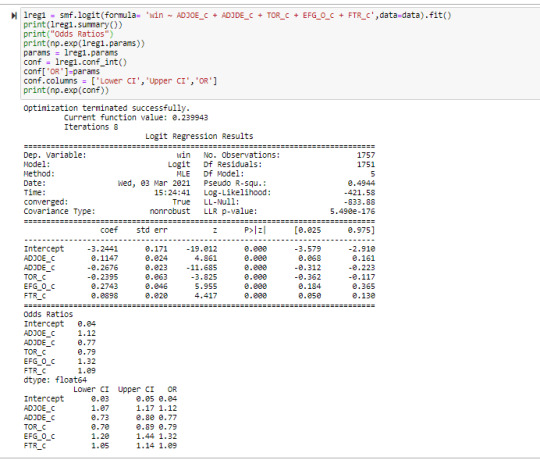Text
Lasso Regression Analysis
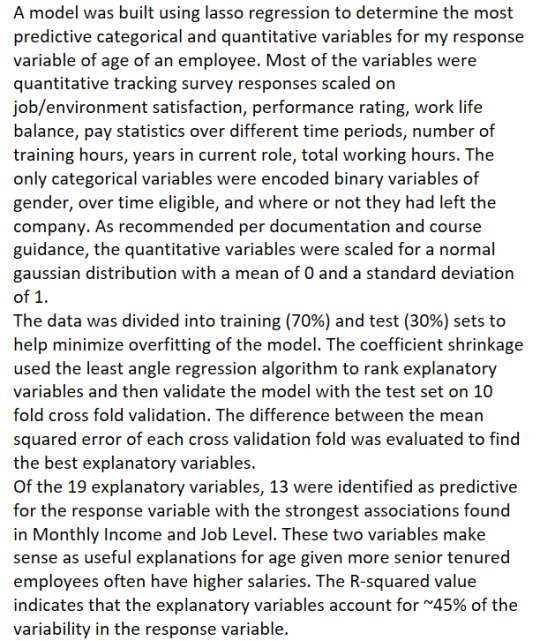

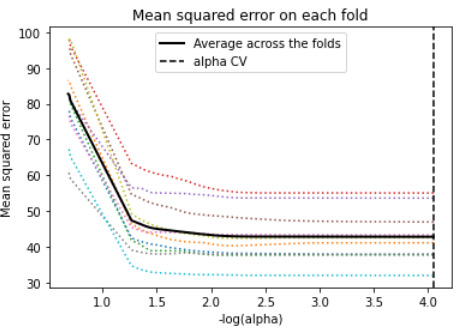
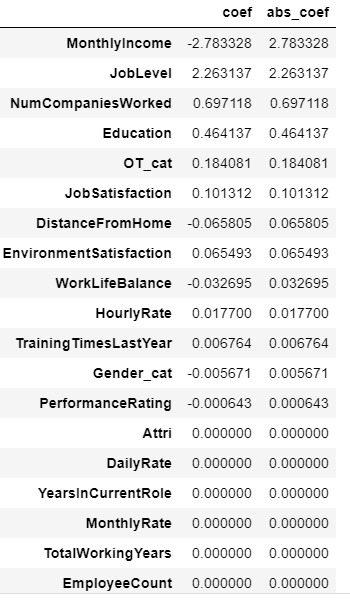
import pandas as pd
import numpy as np
import os
import matplotlib.pylab as plt
from sklearn.metrics import mean_squared_error
from sklearn.model_selection import train_test_split
from sklearn.linear_model import LassoLarsCV
from sklearn import preprocessing
emp_data = pd.read_csv('IBM HR Attrition Data.csv')
emp_data['Age'].describe()
emp_data.isna().sum()
emp_data.dtypes
df = emp_data[['Age','Education','Gender','OverTime','Attrition', 'HourlyRate','YearsInCurrentRole','DailyRate', 'DistanceFromHome','EmployeeCount','JobLevel','JobSatisfaction','EnvironmentSatisfaction', 'MonthlyRate','MonthlyIncome','NumCompaniesWorked','PerformanceRating', 'TotalWorkingYears','TrainingTimesLastYear','WorkLifeBalance','YearsInCurrentRole','TotalWorkingYears']]
df['Attri'] = np.where(df['Attrition'].str.contains("Y"),1,0)
df['Gender_cat'] = np.where(df['Gender'].str.contains("Female"),1,0)
df['OT_cat'] = np.where(df['OverTime'].str.contains("Y"),1,0)
predict = df[['Education','Attri','MonthlyIncome','Gender_cat','OT_cat', 'HourlyRate','YearsInCurrentRole','DailyRate', 'DistanceFromHome','EmployeeCount','JobLevel','JobSatisfaction','EnvironmentSatisfaction', 'MonthlyRate','PerformanceRating','NumCompaniesWorked', 'TotalWorkingYears','TrainingTimesLastYear','WorkLifeBalance','YearsInCurrentRole','TotalWorkingYears']] #'HourlyRate']]#,'Age','HourlyRate'
predictors = predict.copy()
predictors['Education'] = preprocessing.scale(predictors['Education']).astype('float64')
predictors['Attri'] = preprocessing.scale(predictors['Attri']).astype('float64')
predictors['MonthlyIncome'] = preprocessing.scale(predictors['MonthlyIncome']).astype('float64')
predictors['Gender_cat'] = preprocessing.scale(predictors['Gender_cat']).astype('float64')
predictors['OT_cat'] = preprocessing.scale(predictors['OT_cat']).astype('float64')
predictors['HourlyRate'] = preprocessing.scale(predictors['HourlyRate']).astype('float64')
predictors['YearsInCurrentRole'] = preprocessing.scale(predictors['YearsInCurrentRole']).astype('float64')
predictors['DailyRate'] = preprocessing.scale(predictors['DailyRate']).astype('float64')
predictors['DistanceFromHome'] = preprocessing.scale(predictors['DistanceFromHome']).astype('float64')
predictors['EmployeeCount'] = preprocessing.scale(predictors['EmployeeCount']).astype('float64')
predictors['JobLevel'] = preprocessing.scale(predictors['JobLevel']).astype('float64')
predictors['JobSatisfaction'] = preprocessing.scale(predictors['JobSatisfaction']).astype('float64')
predictors['EnvironmentSatisfaction'] = preprocessing.scale(predictors['EnvironmentSatisfaction']).astype('float64')
predictors['MonthlyRate'] = preprocessing.scale(predictors['MonthlyRate']).astype('float64')
predictors['PerformanceRating'] = preprocessing.scale(predictors['PerformanceRating']).astype('float64')
predictors['NumCompaniesWorked'] = preprocessing.scale(predictors['NumCompaniesWorked']).astype('float64')
predictors['TotalWorkingYears'] = preprocessing.scale(predictors['TotalWorkingYears']).astype('float64')
predictors['TrainingTimesLastYear'] = preprocessing.scale(predictors['TrainingTimesLastYear']).astype('float64')
predictors['WorkLifeBalance'] = preprocessing.scale(predictors['WorkLifeBalance']).astype('float64')
predictors['YearsInCurrentRole'] = preprocessing.scale(predictors['YearsInCurrentRole']).astype('float64')
predictors['TotalWorkingYears'] = preprocessing.scale(predictors['TotalWorkingYears']).astype('float64')
targets = df.Age #MonthlyIncome
predictors.head()
pred_train, pred_test, tar_train, tar_test = train_test_split(predictors, targets, test_size=.3)
print(pred_train.shape,pred_test.shape,tar_train.shape,tar_test.shape)
model = LassoLarsCV(cv=10,precompute=False,max_iter=15).fit(pred_train,tar_train)
pred = dict(zip(predictors.columns,model.coef_))
df2 = pd.DataFrame(pred.values(),index=pred.keys(),columns=['coef'])
df2['abs_coef'] = df2['coef'].apply(lambda x: abs(x))
df2.sort_values(by='abs_coef',ascending=False)
len(df2.index)
m_log_alphas = -np.log10(model.alphas_)
ax = plt.gca()
plt.plot(m_log_alphas, model.coef_path_.T)
plt.axvline(-np.log10(model.alpha_), linestyle='--', color='k',
label='alpha CV')
plt.ylabel('Regression Coefficients')
plt.xlabel('-log(alpha)')
plt.title('Regression Coefficients Progression for Lasso Paths')
m_log_alphascv = -np.log10(model.cv_alphas_)
plt.figure()
plt.plot(m_log_alphascv, model.mse_path_, ':') # plot mse with dotted line
plt.plot(m_log_alphascv, model.mse_path_.mean(axis=-1), 'k',
label='Average across the folds', linewidth=2)
plt.axvline(-np.log10(model.alpha_), linestyle='--', color='k',
label='alpha CV')
plt.legend()
plt.xlabel('-log(alpha)')
plt.ylabel('Mean squared error')
plt.title('Mean squared error on each fold')
train_error = mean_squared_error(tar_train, model.predict(pred_train))
test_error = mean_squared_error(tar_test, model.predict(pred_test))
print (f'training data MSE: {train_error}')
print (f'test data MSE: {test_error}')
# R-square from training and test data
rsquared_train = model.score(pred_train,tar_train)
rsquared_test = model.score(pred_test,tar_test)
print (f'training data R-square: {rsquared_train}')
print (f'test data R-square: {rsquared_test}')
0 notes
Text
Random Forest Attrition Analysis

from pandas import Series, DataFrame
import pandas as pd
import numpy as np
import os
import matplotlib.pylab as plt
from sklearn.model_selection import cross_validate
from sklearn.model_selection import train_test_split
#train_test_split
from sklearn.tree import DecisionTreeClassifier
from sklearn.metrics import classification_report
import sklearn.metrics
from sklearn import tree
from sklearn import datasets
from sklearn.ensemble import ExtraTreesClassifier
from sklearn.ensemble import RandomForestClassifier
emp_data = pd.read_csv('IBM HR Attrition Data.csv')
emp_data.isna().sum()
emp_data.dtypes
emp_data['PerformanceRating'].describe()
df = emp_data[['Age','Education','Gender','OverTime', 'HourlyRate','YearsInCurrentRole','DailyRate', 'DistanceFromHome','EmployeeCount','JobLevel','JobSatisfaction','EnvironmentSatisfaction', 'MonthlyRate','MonthlyIncome','NumCompaniesWorked','PerformanceRating', 'TotalWorkingYears','TrainingTimesLastYear','WorkLifeBalance','YearsInCurrentRole','TotalWorkingYears']]
df['Gender_cat'] = np.where(df['Gender'].str.contains("Female"),1,0)
df['OT_cat'] = np.where(df['OverTime'].str.contains("Y"),1,0)
predictors = df[['Age','Education','Gender_cat','OT_cat', 'HourlyRate','YearsInCurrentRole','DailyRate', 'DistanceFromHome','EmployeeCount','JobLevel','JobSatisfaction','EnvironmentSatisfaction', 'MonthlyRate','MonthlyIncome','NumCompaniesWorked','PerformanceRating', 'TotalWorkingYears','TrainingTimesLastYear','WorkLifeBalance','YearsInCurrentRole','TotalWorkingYears']] #'HourlyRate']]#,'Age','HourlyRate'
targets = emp_data.Attrition
pred_train, pred_test, tar_train, tar_test = train_test_split(predictors, targets, test_size=.4)
print(pred_train.shape,pred_test.shape,tar_train.shape,tar_test.shape)
classifier = RandomForestClassifier(n_estimators=25)
classifier = classifier.fit(pred_train,tar_train)
predictions = classifier.predict(pred_test)
print(sklearn.metrics.confusion_matrix(tar_test,predictions))
sklearn.metrics.accuracy_score(tar_test,predictions)
model = ExtraTreesClassifier()
model.fit(pred_train,tar_train)
print(model.feature_importances_)
col_rank = {}
for col,rk in zip(predictors.columns,model.feature_importances_):
col_rank[col] = rk
pred = pd.DataFrame(col_rank.values(),index=col_rank.keys(),columns={'rank'})
pred.head()
pred.sort_values(by=['rank'],ascending=False)
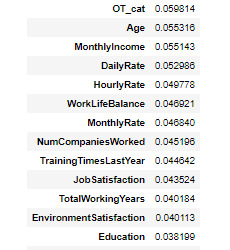
trees=range(25)
accuracy=np.zeros(25)
for idx in range(len(trees)):
classifier = RandomForestClassifier(n_estimators=idx + 1)
classifier = classifier.fit(pred_train,tar_train)
predictions = classifier.predict(pred_test)
accuracy[idx] = sklearn.metrics.accuracy_score(tar_test, predictions)
plt.cla()
plt.plot(trees, accuracy);
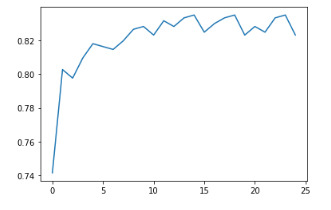
0 notes
Text
Decision Tree Modeling HR Attrition Data

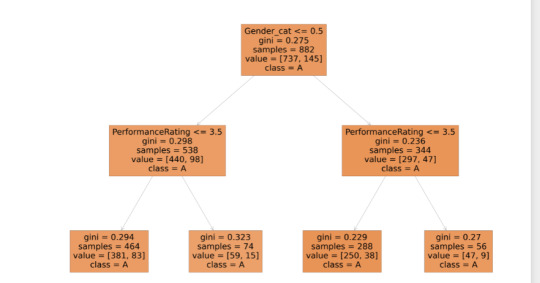
from pandas import Series, DataFrame
import pandas as pd
import numpy as np
import os
import matplotlib.pylab as plt
from sklearn.model_selection import cross_validate
from sklearn.model_selection import train_test_split
#train_test_split
from sklearn.tree import DecisionTreeClassifier
from sklearn.metrics import classification_report
import sklearn.metrics
from sklearn import tree
df.dtypes
emp_data = pd.read_csv('IBM HR Attrition Data.csv')
emp_data.isna().sum()
emp_data.dtypes
emp_data['PerformanceRating'].describe()
count 1470.000000 mean 3.153741 std 0.360824 min 3.000000 25% 3.000000 50% 3.000000 75% 3.000000 max 4.000000
df = emp_data[['Age','Education','Gender','OverTime',\
'HourlyRate','YearsInCurrentRole','PerformanceRating',\
'YearsInCurrentRole','TotalWorkingYears']]
df['Gender_cat'] = np.where(df['Gender'].str.contains("Female"),1,0)
predictors = df[['PerformanceRating','Gender_cat']]
targets = emp_data.Attrition
pred_train, pred_test, tar_train, tar_test = train_test_split(predictors, targets, test_size=.4)
print(pred_train.shape,pred_test.shape,tar_train.shape,tar_test.shape)
classifier = DecisionTreeClassifier()
classifier = classifier.fit(pred_train,tar_train)
predictions = classifier.predict(pred_test)
sklearn.metrics.confusion_matrix(tar_test,predictions)
sklearn.metrics.accuracy_score(tar_test,predictions) 0.8163265306122449
fig = plt.figure(figsize=(75,50))
_ = tree.plot_tree(classifier,feature_names=predictors.columns,class_names='Attrition',filled=True)
0 notes
Text
Multiple Linear Regression Relationship in College Basketball
After incorporating two dependent variables into the regression model, it was evident that both were statistically significant in predicting wins metric (WAB: wins above bubble meaning the average team). Both adjusted offensive and defensive efficiency (after normalizing around 0) had a very low P-value (0.000) in the t-score. The offensive metric had a positive coefficient of 0.5626 as it has a positive linear relationship with the response variable and represents a half of a win more than the average team with each additional offensive efficiency. The defensive metric had a coefficient of -0.5384 as it had a negative relationship with the response variable and for each additional point decline in defensive efficiency there is just more than a half fewer wins. As hypothesized these two statistics reflect that they are significant in predicting wins during the college basketball tournament.
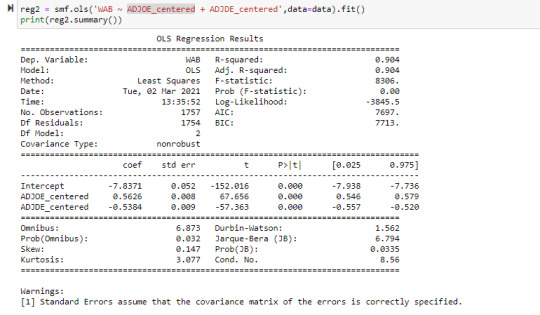
There was not evidence of confounding between these two variables as the P-values remained very statistically significant after adding in the additional explanatory variable (comparing against a linear model). Also from reviewing the partial regression plot the relationship between both adjusted offensive and defensive efficiency remained quite linear after accounting for the other variables.
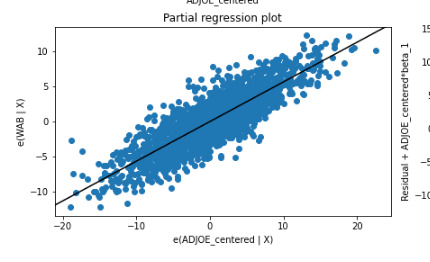

The QQ plot seems to indicate that there is a normal distribution as the points follow the sample quantile line fairly closely except for a few of the larger outliers.

When reviewing the standardized residual plot the vast majority of points were still found within the 2 standard deviation cutoffs (34 teams >= 2 STD and 31 teams <=-2 STD) and those points including outliers only accounted for just under 4 percent of the data further indicating normalized variability.

Despite the normal relationship the influence plot did indicate there were several outlier points, with the largest being point 1338, that had a large influence over the regression model. This is worth further consideration to exclude from the model to prevent undue influence in skewing some of the predicted values. Most of the influential points were in fact within 1 to 2 standard deviations from the mean.

Remaining code is included below:

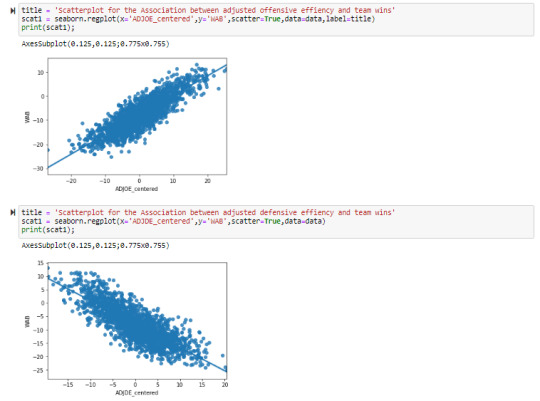

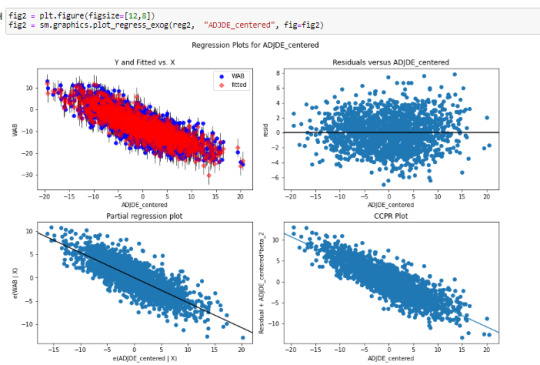
0 notes
Text
Testing the linear association between Adjusted Offensive Efficiency and Wins
There was a strong positive relationship between these two variables as shown in the below snapshot of code and visuals.
Framework import:
import numpy as np
import pandas as pd
import statsmodels.api as sm
import statsmodels.formula.api as smf
import matplotlib as plt
import seaborn
pd.set_option("display.float_format",lambda x:'%.2f'%x)
Previewing input data:
data = pd.read_csv('cbb.csv')
data.head()

Scaling numerical explanatory variable around zero:
#centering the quant explanatory variable
data['ADJOE_centered'] = data['ADJOE'] - data['ADJOE'].mean()
data['ADJDE_centered'] = data['ADJDE'] - data['ADJDE'].mean()
Building scatterplot of explanatory vs response:
title = 'Scatterplot for the Association between adjusted offensive effiency and team wins'
scat1 = seaborn.regplot(x='ADJOE_centered',y='W',scatter=True,data=data,label=title)
print(scat1);
Scatterplot for the association between adjusted offensive efficiency and team wins

Running basic linear regression model:
print ("OLS regression model determining the association between offensive efficiency and win in Division 1 College Basketball")
reg1 = smf.ols('W ~ ADJOE_centered', data=data).fit()
#requests fit statistics
print (reg1.summary()) # summary regression stats
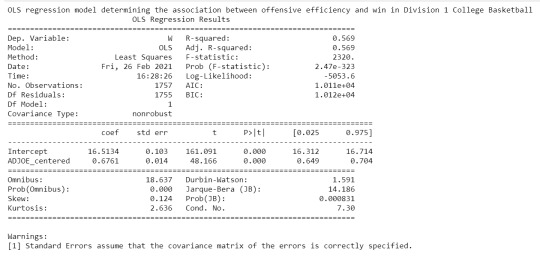
Summary:
The results from the simple linear regression model indicate that adjusted offensive efficiency is a statistically significant predictor for team wins as does the small P-value below the alpha level of 0.05. The scatterplot as well as the coefficient show a positive relationship between this set of explanatory and response variables. The R-squared statistic also indicates that approximately 56% of the variability in wins can be explained by the adjusted offensive efficiency.
0 notes
Text
College Basketball Statistics Preliminary Write Up
Sample: The sample of data that I’ll be working through in the Regression Modeling course is a college basketball dataset showing team performance and postseason results in anticipation for March Madness. The data set includes results from 2015-2019 seasons for all 351 teams as well as the round in which they were eliminated if relevant from postseason data.
Procedures: The data was collected from Kaggle, a online data aggregator website owned by Google, which the individual poster scraped from another college basketball data website (https://barttorvik.com/). That website normally runs statistical analysis on some of advanced statistics for the sport and has built their own rating metric for teams.
Measures: There are a number of useful statistics that are captured in the dataset. Adjusted Offensive efficiency is an estimate of the number of points a team would score over 100 possessions, while adjusted defensive efficiency is the estimate of the number of points allowed to another team over 100 possessions. These two quantitative statistics are very useful to compare teams across conferences as they adjust for the level of competition that each team might play over the course of a season. The offensive efficiency ranges from 75 through 129, while defensive efficiency is from 84 through 125. Both variables will need to be scaled around 0 for reference to other potential explanatory variables. I will be comparing both of these variables individually to see if either is more predictive of the number of wins a team has over the course of a season.
1 note
·
View note
